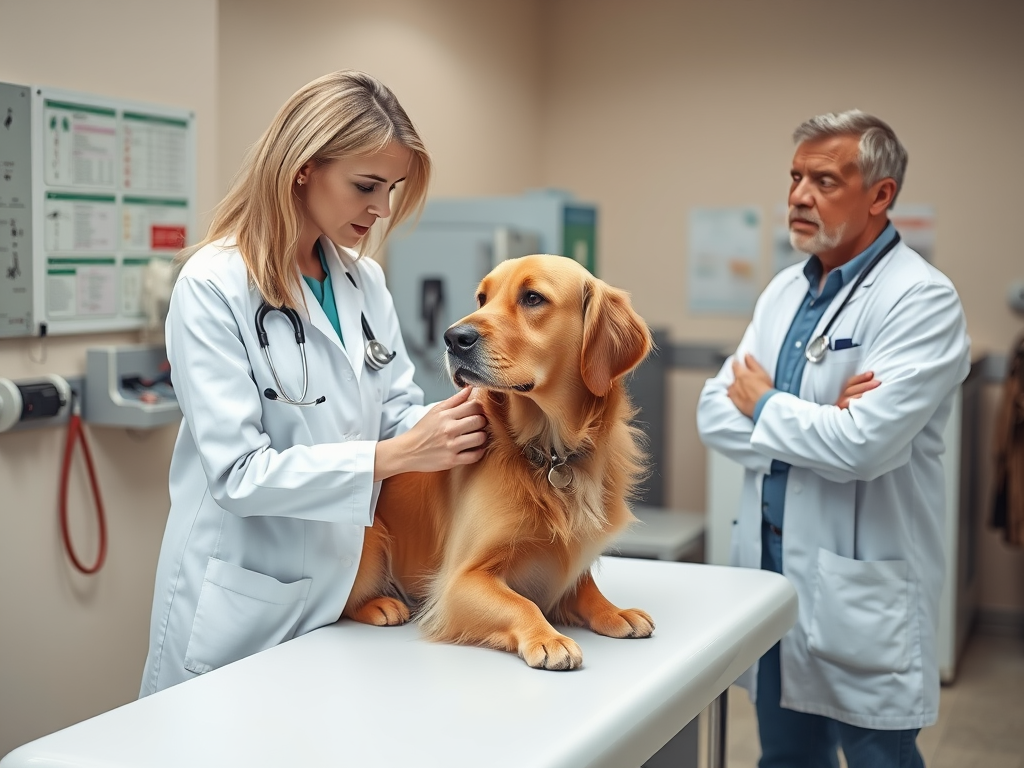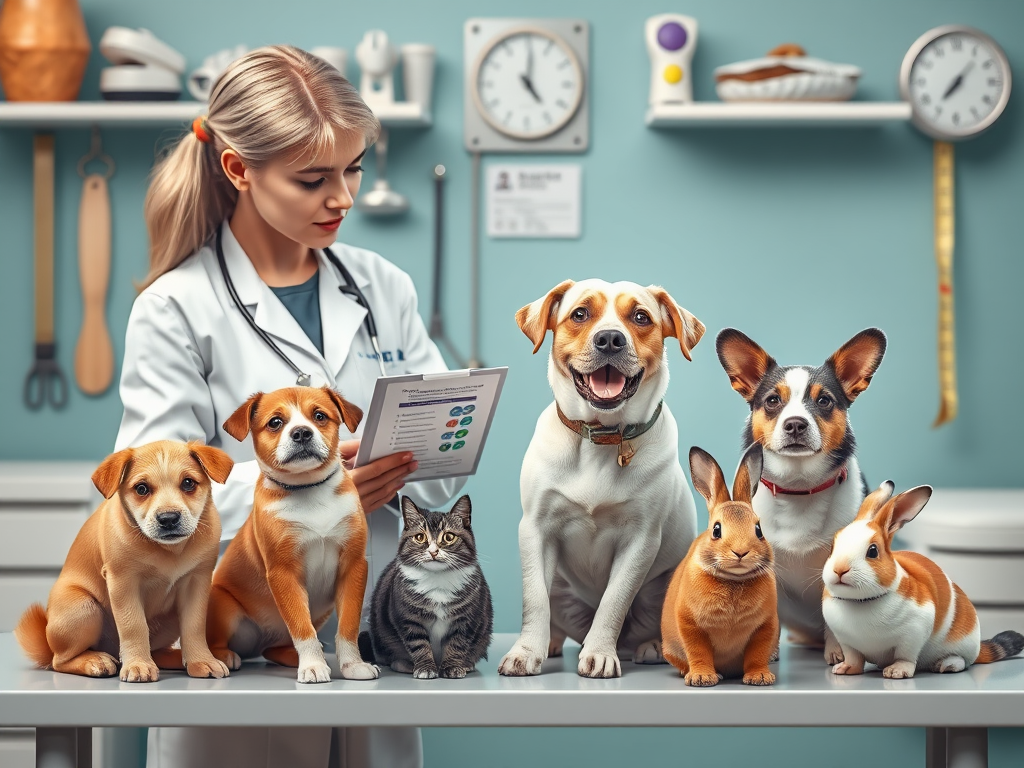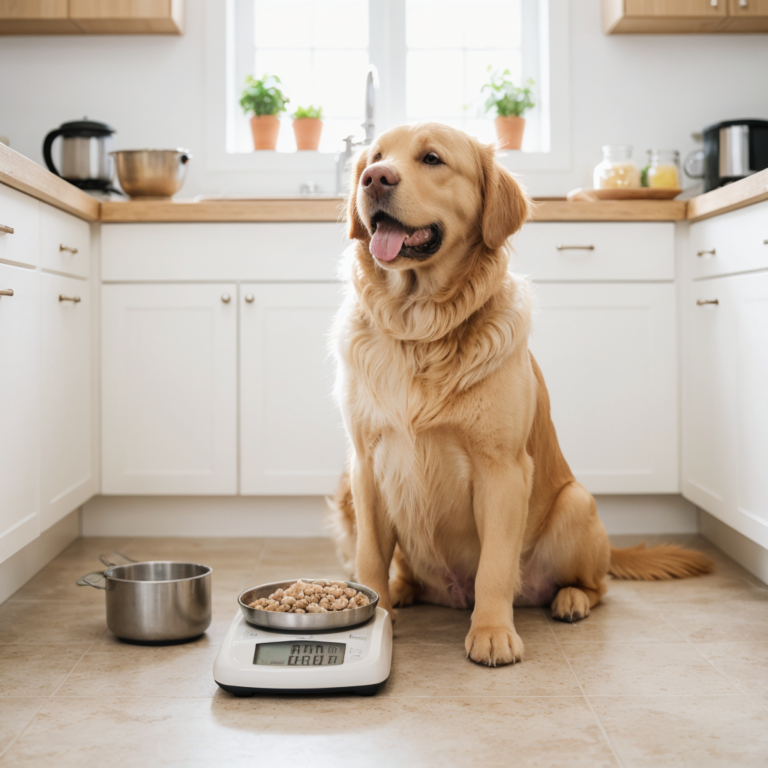As the calendar turns to a new year, many of us make resolutions for ourselves—but what about our furry companions? 🐾 Just like humans, pets can benefit from a fresh start and renewed focus on their health and well-being. However, setting realistic goals for our four-legged friends can be challenging. How do we know what’s best for them, and where do we even begin?
Enter our guide: “7 Steps to Set Realistic Health Goals for Your Pet in the New Year.” This comprehensive approach will help you assess your pet’s current health status, identify areas for improvement, and create a tailored plan for success. Whether your furry friend needs to shed a few pounds, increase their activity level, or simply maintain their good health, we’ve got you covered. By following these steps, you’ll be able to set SMART goals that are Specific, Measurable, Achievable, Relevant, and Time-bound—ensuring the best possible outcomes for your beloved pet.
In this blog post, we’ll walk you through the process of creating a pet wellness plan that works. From assessing your pet’s current health to planning a balanced diet and creating consistent routines, we’ll cover all the essentials. So, let’s embark on this journey together and make this year your pet’s healthiest yet!
Assess Your Pet’s Current Health Status

A. Schedule a comprehensive veterinary check-up
To assess your pet’s current health status, the first step is to schedule a comprehensive veterinary check-up. This examination is crucial for maintaining your pet’s overall well-being and detecting any potential health issues early on. During the check-up, your veterinarian will:
- Gather your pet’s medical history
- Observe your pet’s behavior
- Perform a physical examination
- Conduct diagnostic tests
The physical examination includes checking vital signs, examining the coat and skin, and assessing the eyes, ears, and mouth. Diagnostic tests may involve:
- Blood tests (Complete Blood Count and chemistry panels)
- Urinalysis
- Fecal testing for internal parasites
- Blood pressure assessments
These tests help evaluate overall health, detect diseases, and provide insights into your pet’s internal health.
B. Identify existing health issues or concerns
During the veterinary check-up, your vet will work to identify any existing health issues or concerns. This process involves:
- Discussing any concerns you have about your pet’s health
- Evaluating diagnostic test results
- Assessing your pet’s body condition score (BCS)
- Screening for heartworms and other parasites
For older pets, additional attention may be given to age-related issues such as arthritis and cognitive decline. Your vet may also perform:
| Test | Purpose |
|---|---|
| X-rays | Evaluate internal organs and skeletal structure |
| Ultrasounds | Examine soft tissues and organs in detail |
| Thyroid testing | Check for thyroid function abnormalities |
C. Evaluate current diet and exercise routine
As part of assessing your pet’s health status, it’s essential to evaluate their current diet and exercise routine. Your veterinarian will:
- Discuss your pet’s nutritional needs
- Assess the appropriateness of their current diet
- Recommend balanced diets or supplements if necessary
- Evaluate your pet’s exercise habits
This evaluation helps ensure that your pet is maintaining a healthy weight and receiving proper nutrition for their life stage. Your vet may provide guidance on:
- Portion control
- Specific dietary requirements based on health conditions
- Appropriate exercise routines for your pet’s breed and age
With this comprehensive assessment of your pet’s current health status, you’ll be well-prepared to move on to the next step: Identifying Specific Areas for Improvement. This evaluation will serve as a foundation for setting realistic and tailored health goals for your pet in the coming year.
Identify Specific Areas for Improvement

Now that we have assessed your pet’s current health status, it’s time to identify specific areas for improvement. This step is crucial in developing a targeted approach to enhance your pet’s overall well-being.
A. Weight management
Weight management is a critical aspect of your pet’s health. According to recent statistics, there’s a high prevalence of obesity in U.S. pets, which can lead to severe health issues such as diabetes and heart disease. To address this:
- Use Body Condition Scoring (BCS) to assess your pet’s weight
- Consult with your veterinarian to create a personalized weight management plan
- Adjust your pet’s diet according to their life stage (e.g., higher protein for puppies, lower-calorie for older pets)
B. Dental health
Daily dental care is essential to prevent periodontal disease and other serious health complications. Consider implementing the following:
- Regular tooth brushing
- Dental treats
- Professional cleanings as recommended by your vet
C. Physical activity level
Exercise and mental stimulation are vital for your pet’s overall well-being. Here’s a comparison of activities for dogs and cats:
| Dogs | Cats |
|---|---|
| Daily walks | Interactive toys |
| Fetch games | Climbing structures |
| Agility training | Laser pointer play |
| Swimming | Puzzle feeders |
D. Behavioral issues
Understanding and addressing behavioral problems is crucial for a harmonious pet-owner relationship. Common issues include:
- Aggression
- Separation anxiety
- Excessive barking or meowing
To improve behavior:
- Implement consistent training routines
- Provide environmental enrichment
- Consider calming aids like specialized beds or familiar scents
- Consult with a professional behaviorist for persistent issues
With these specific areas identified, we can now move on to setting SMART goals for your pet. This approach will help ensure that the improvements we aim for are Specific, Measurable, Achievable, Relevant, and Time-bound, providing a clear roadmap for enhancing your pet’s health and happiness in the coming year.
Set SMART Goals for Your Pet

Now that we’ve identified specific areas for improvement in your pet’s health, it’s time to set SMART goals to achieve these improvements. SMART goals provide a structured approach to goal-setting, increasing the likelihood of success in your pet’s health journey.
A. Make goals Specific and Measurable
When setting health goals for your pet, it’s crucial to be specific about what you want to achieve. Instead of a vague goal like “I want my dog to be healthier,” refine it to something more concrete, such as “I want my dog to lose 10 pounds by the end of next year.” This specificity defines the desired outcome clearly.
To ensure your goals are measurable, use quantifiable metrics. For example:
- Daily step count for your pet
- Weight loss in pounds
- Number of training sessions per week
B. Ensure goals are Achievable and Realistic
While it’s important to be ambitious, your pet’s health goals should also be attainable given your available resources and your pet’s current condition. For instance, if your pet is new to exercise, setting a goal to run a marathon in a month would be unrealistic and potentially harmful.
Consider the following factors when setting achievable goals:
- Your pet’s current fitness level
- Available time for training or lifestyle changes
- Any existing health conditions
- Your veterinarian’s recommendations
C. Set Time-bound objectives
Establishing deadlines for your pet’s health goals creates a sense of urgency and helps maintain focus. Time-bound objectives can be categorized into short-term and long-term goals:
| Goal Type | Example | Timeframe |
|---|---|---|
| Short-term | Increase daily walk duration by 10 minutes | 1 month |
| Long-term | Achieve ideal weight as recommended by vet | 6 months |
Remember to break down longer-term goals into smaller, manageable milestones. This approach allows you to track progress and adjust your strategy if needed.
By applying the SMART framework to your pet’s health goals, you’re setting a clear path for improvement. This structured approach not only increases the chances of success but also allows for better monitoring and adjustment of your pet’s health plan over time.
With these SMART goals in place, we’ll next explore how to create an action plan to turn these objectives into reality for your pet’s health journey.
Create an Action Plan

Now that we’ve set SMART goals for your pet, it’s time to create an action plan to achieve them. This plan will help you implement practical steps towards improving your pet’s health and well-being.
Design a balanced diet plan
A balanced diet is crucial for your pet’s overall health. Consider implementing a comprehensive health plan that covers nutritional needs:
- Consult with your veterinarian to develop a tailored diet plan
- Include year-round preventative treatments against parasites
- Ensure proper hydration
Establish an exercise routine
Regular exercise is essential for maintaining your pet’s physical and mental health. Here’s a simple table to help you plan:
| Pet Type | Exercise Duration | Frequency |
|---|---|---|
| Dogs | 30-60 minutes | Daily |
| Cats | 15-30 minutes | 2-3x/day |
| Rabbits | 3-4 hours | Daily |
Schedule regular health check-ups
Preventive care is key to your pet’s long-term health. Consider joining a pet health club that offers:
- Annual vaccinations
- Biannual health checks
- Unlimited consultations with veterinarians
- Discounts on dental care and medications
Implement training strategies for behavioral goals
To address behavioral issues:
- Identify specific areas for improvement
- Set measurable goals (e.g., reduce barking by 50% in 3 months)
- Use positive reinforcement techniques
- Track progress and adjust strategies as needed
Remember, consistency is crucial when implementing your action plan. By following these steps and utilizing available resources like pet health clubs and veterinary expertise, you’ll be well on your way to improving your pet’s health and happiness.
With this comprehensive action plan in place, we can now focus on the next crucial step: transitioning to a balanced diet that supports your pet’s specific health needs and goals.
Transition to a Balanced Diet

Identify Nutritional Needs
Functional nutrition plays a crucial role in creating a diet tailored to your pet’s specific needs. By focusing on key nutrients, you can address various health concerns and promote overall well-being. Here are some examples:
| Nutrient | Function | Benefits |
|---|---|---|
| Omega-3s | Anti-inflammatory | Reduces joint pain, improves skin health |
| Fiber | Digestive support | Aids in digestion, promotes gut health |
| Antioxidants | Cellular protection | Boosts immune system, fights free radicals |
Meal Plans
When considering your pet’s diet, you have several options:
- Fresh food diets: Provide maximum nutrition and minimize processing
- Home-cooked meals: Allow for complete control over ingredients
- High-quality commercial diets: Offer convenience without sacrificing nutrition
Supplementation
Importance of active forms in supplements:
- Choose DHA instead of generic fish oil for better absorption
- Opt for chelated minerals for improved bioavailability
- Select probiotics with multiple strains for comprehensive gut health
Transition Tips
- Gradually introduce new foods over 7-10 days
- Mix increasing amounts of new food with decreasing amounts of old food
- Monitor your pet for signs of gastrointestinal distress
- Observe for potential allergies or sensitivities during the transition period
Now that we’ve covered the essentials of planning a balanced diet, let’s move on to creating a consistent routine for your pet’s health goals.
Create a Routine for Consistency

Meal Timing: The importance of feeding schedules
Establishing a consistent feeding schedule is crucial for your pet’s metabolic stability and energy balance. A regular routine helps regulate their digestive system and prevents overeating. Here’s a simple guide to meal timing:
| Meal | Time | Benefits |
|---|---|---|
| Breakfast | 7-8 AM | Kickstarts metabolism |
| Dinner | 5-6 PM | Provides energy for evening activities |
Exercise and Enrichment
Pairing diet goals with exercise routines significantly improves overall health. Incorporate these activities into your pet’s daily schedule:
- 20-minute walks (morning and evening)
- Interactive play sessions
- Food puzzles for mental stimulation
Monitoring Progress
Keeping a journal is essential for tracking your pet’s progress. Record the following information daily:
- Weight
- Appetite
- Energy levels
- Coat condition
Metabolomics: Fine-tuning the diet
Metabolomics, the study of small molecules in biological samples, can help optimize your pet’s diet over time. This advanced approach allows for:
- Identification of metabolic imbalances
- Personalized nutritional adjustments
- Early detection of potential health issues
By implementing these strategies consistently, you’ll create a routine that supports your pet’s health goals effectively. Remember, consistency is key in achieving and maintaining optimal health for your furry friend.
Monitor Progress and Adjust as Needed

Now that we have established a consistent routine for your pet’s health goals, it’s crucial to monitor progress and make adjustments as needed. This ongoing process ensures that your pet continues to thrive and meet their health objectives.
Keep a pet health journal
Maintaining a detailed record of your pet’s health is essential for tracking progress. Utilize apps like VitusVet or My Pet to document:
- Daily activities
- Growth metrics (height and weight)
- Veterinary appointments
- Medication schedules
- Vaccination records
These digital tools allow you to organize information efficiently and share it with veterinarians or caregivers when needed.
Regularly reassess goals
As you track your pet’s progress, it’s important to periodically review and adjust your goals. Consider using activity trackers like FitBark 2 or Whistle Go Explore to monitor:
| Tracker | Features |
|---|---|
| FitBark 2 | Step tracking, anxiety monitoring |
| Whistle Go Explore | Health insights, GPS tracking |
These devices can provide valuable data on your pet’s activity levels, sleep patterns, and overall behavior, helping you make informed decisions about their health goals.
Celebrate small victories
Recognizing and celebrating your pet’s progress, no matter how small, is crucial for maintaining motivation. Use apps like DogLog to:
- Log daily achievements
- Share progress with family and friends
- Set and track milestones
By acknowledging these accomplishments, you’ll stay encouraged and committed to your pet’s health journey.
Consult with your veterinarian for guidance
Regular check-ins with your veterinarian are essential for ensuring your pet’s health goals remain appropriate and achievable. Consider using tools like:
- MySimplePetLab for at-home diagnostic tests
- Vetster.com for virtual vet consultations
- Pet Diabetes Tracker or PetDialog for managing specific health conditions
These resources can provide valuable insights to discuss with your veterinarian, allowing for more informed decisions about your pet’s health plan. Remember to share the data collected from your pet health journal and activity trackers during these consultations to get the most comprehensive guidance.

Setting realistic health goals for your pet in the New Year is a proactive step towards ensuring their long-term well-being. By following the seven steps outlined in this post—assessing your pet’s current health, identifying areas for improvement, setting SMART goals, creating an action plan, and transitioning to a balanced diet—you’re laying the foundation for a healthier, happier companion. Remember to establish a consistent routine and monitor your pet’s progress, adjusting your approach as needed.
As you embark on this journey to improve your pet’s health, don’t forget the importance of regular veterinary check-ups and preventative care. These play a crucial role in catching potential issues early and maintaining your pet’s overall wellness. Whether it’s increasing physical activity, enhancing mental stimulation, or focusing on better nutrition, every small step counts towards your pet’s improved quality of life. Make this year your pet’s healthiest yet by committing to these realistic and impactful health goals.
References
- Metabolomics in Veterinary Medicine
https://www.mdpi.com/journal/metabolites/special_issues/Veterinary_Metabolomics - Functional Foods in Pet Nutrition
https://actascientific.com/ASNH/pdf/ASNH-04-0627.pdf - Adaptive Nutrition in Aging Pets
https://link.springer.com/chapter/10.1007/978-3-031-54192-6_9 - Orthomolecular Therapy in Veterinary Practice
https://todaysveterinarypractice.com/preventive-medicine/animal-hallmarks-of-aging/ - Effects of Functional Foods on Pet Health
https://www.petfoodindustry.com/nutrition/pet-food-ingredients/article/15463777/functional-foods-effects-on-dog-cat-health-summarized - Senior Pet Nutrition and Management
https://www.vetsmall.theclinics.com/article/S0195-5616%2821%2900014-0/fulltext






